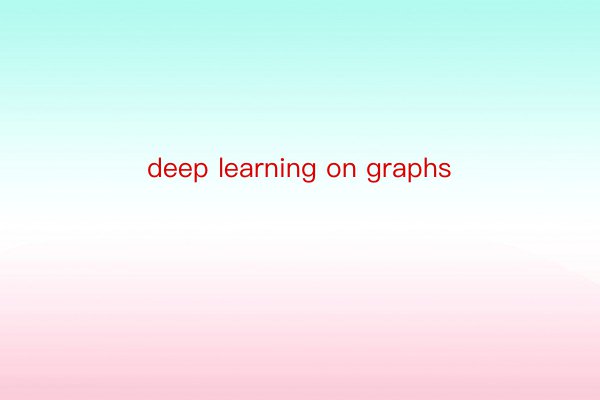欢迎您访问:太阳城游戏网站!1.产品概述:铁氟龙的高品质钢衬PTFE金属软管和不锈钢衬氟波纹软管是由不锈钢编织管和PTFE管组成的,具有良好的耐腐蚀性、耐高温性、耐压性和耐磨性等特点。其主要应用于化工、医药、食品、航空航天等领域。

Introduction:
Deep learning has revolutionized the field of artificial intelligence, enabling machines to learn and make predictions from complex data. While deep learning algorithms have been highly successful in various domains, such as image recognition and natural language processing, their application to graph-structured data has gained significant attention in recent years. In this article, we will explore the concept of deep learning on graphs and how it can unlock the power of data relationships.
Deep learning on graphs involves leveraging neural networks to process and analyze data represented in graph structures. Unlike traditional deep learning approaches that operate on grid-like data, such as images or sequences, deep learning on graphs considers the relationships between data points, which are represented as nodes and edges in a graph. By capturing the inherent connections and dependencies within the data, deep learning on graphs enables more accurate predictions and insights.
Graph Convolutional Networks (GCNs) are a popular and powerful approach for deep learning on graphs. GCNs extend the traditional convolutional neural networks (CNNs) to handle graph-structured data. They effectively combine information from neighboring nodes to propagate and update features throughout the graph. This enables GCNs to capture both local and global patterns in the data, making them highly effective for tasks such as node classification, link prediction, and graph generation.
1. Social Network Analysis:

Deep learning on graphs has found applications in social network analysis, where the relationships between individuals are represented as a graph. By analyzing the graph structure and node attributes, deep learning models can predict user behaviors, identify influential individuals, and detect communities within the network.
2. Recommendation Systems:
Deep learning on graphs has also been applied to recommendation systems, where user-item interactions are represented as a graph. By leveraging the relationships between users and items, deep learning models can provide personalized recommendations,太阳城游戏 improve user engagement, and enhance the overall user experience.
3. Drug Discovery:
Deep learning on graphs has shown promise in the field of drug discovery, where molecules and their interactions are represented as a graph. By analyzing the graph structure and chemical properties, deep learning models can assist in identifying potential drug candidates, predicting their properties, and accelerating the drug discovery process.
While deep learning on graphs holds great potential, it also faces several challenges. One of the main challenges is scalability, as graph-structured data can be extremely large and complex. Additionally, the interpretability of deep learning models on graphs remains a topic of ongoing research.
Despite these challenges, the field of deep learning on graphs is rapidly evolving, with researchers exploring new architectures, algorithms, and techniques. As the understanding and capabilities of deep learning on graphs continue to advance, we can expect even more exciting applications and breakthroughs in the future.
In conclusion, deep learning on graphs provides a powerful framework for unlocking the hidden insights and patterns within graph-structured data. By incorporating the relationships between data points, deep learning models can make more accurate predictions and enable a wide range of applications across various domains. As the field continues to progress, deep learning on graphs will undoubtedly play a crucial role in shaping the future of artificial intelligence.